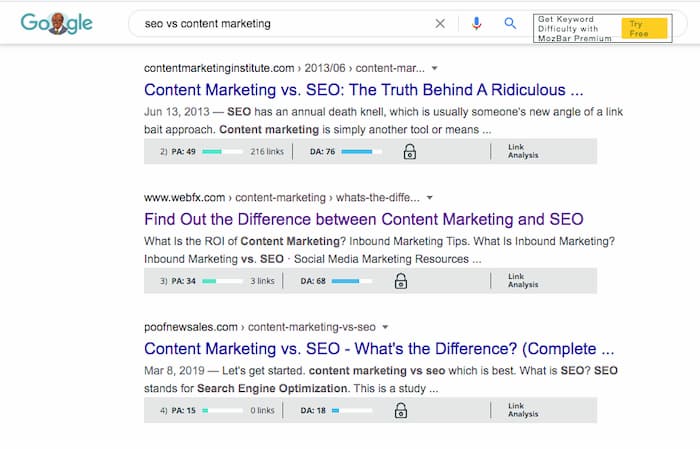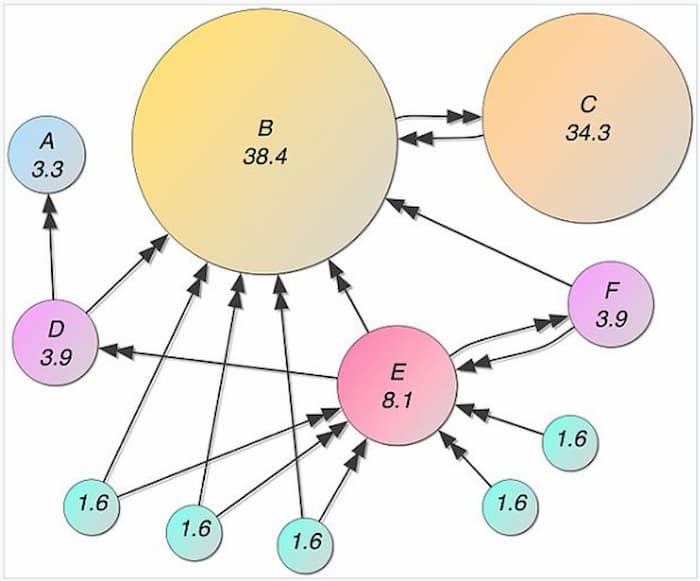
You may have heard the phrase domain authority being passed around quite a bit and it’s probably for good reason. Many SEOs use the term to describe the likeliness of a website to rank since it refers to the aggregate link equity a domain possesses.
The truth is that domain authority or DA is a term and value that has been formulated and branded by Moz. Other companies have their own versions of how they measure it but the entire concept is a proprietary metric Google used in its algorithm called PageRank.
Table of Contents
ToggleWhat is PageRank?
To be honest, no one knows for sure what exactly went into the PageRank calculation, but what we do know is that it had a lot to do with external backlinks. Google used to disclose the PageRank of every page on the internet. This way you would know how powerful a page was and whether it had a strong ability to rank.
PageRank is based on one of Google’s earliest patents. It states that the popularity of a site could be measured by how many websites linked to it. This is baked into the Google ranking algorithm and remains true today since backlinks are among the top three ranking factors.
The more backlinks a website possesses from relevant websites, the more ranking power it gains. This flow of “link juice” is commonly referred to as “authority.” When a website accumulates thousands of links from related websites, its authority grows.
In 2016, Google stopped publicly displaying PageRank because it contributed to rank manipulation. People would focus on PageRank rather than relevance when linking to other websites in an attempt to boost the ranking ability of their page.
When PageRank stopped being published, a few companies developed their own system for assigning a similar value to web pages. Moz was among the first to come up with DA or domain authority, which measured the aggregate link equity of a domain.
Page authority vs. domain authority
Page authority represents the aggregate link equity of a specific page. Google doesn’t rank domains in the search results it ranks pages. This makes PA or page authority a more accurate measure of the ranking ability of a specific page.
The content on a page is what counts as being relevant to a search. This means that even if your domain authority is considerably lower than another website, you can compete with their pages if you have enough support from other websites linking to your page to bridge the gap in authority-assuming your content is a better solution to search intent.
Advantage of high DA
Keep in mind that a high authority domain has a head start on low authority domains when they publish a new page.
For example, a website with a DA of 80 can publish a brand new blog post whose page authority automatically starts at 45 DA.
Whereas when a website with a DA of 33 publishes a new blog post the new page will start with a DA of 18.
Therefore it will take more backlinks for the lower DA website to even out the page authority when competing for the same keyword in the search results.
The importance of domain authority
The truth is that the higher the authority, the easier it is to rank. It’s easy to get hung up on page authority and domain authority because there’s a specific value to compete with, however, it’s not the only thing that will rank a web page.
Google has actually stated that domain authority doesn’t exist.
we don't really have "overall domain authority". A text link with anchor text is better though
— Gary 鯨理/경리 Illyes (so official, trust me) (@methode) October 27, 2016
Here’s a video of John Mueller actually stating they don’t use overall website authority scoring.
That may be true for them but for SEOs and businessmen, it helps to know what you’re up against when you’re considering keywords to target. If you see 8 out of 10 websites on the first page with a DA over 80, you know you’re in for a long battle to get anywhere near the first page.
Domain authority places your domain in a general category that’s comparable to other websites. It gives you an idea of how close the website is in terms of credibility and authority.
DA in link building
Link building is not an easy task these days, so having a high domain authority is a big advantage to ranking in the search results. Linking from high DA websites is a big advantage because they drive your DA up higher.
PA in link building
Page authority is more accurate in measuring link authority when it comes to ranking for keywords. It gives pages a chance to compete with high DA websites. When there is good content on a page that serves the intent of the search and other websites are linking to it like crazy, it’s going to move up in the search results.
This doesn’t necessarily mean that it’s only because of the links and actual value of PA. It’s a combination of the fact that people are linking to the content because it’s obviously worth linking to in the first place.
There are plenty of instances where low DA sites rank on the same page as high DA websites. It just depends on the content, the optimiztion and how many links the lower DA site has to compete with the higher authority websites.
Here’s an example of a website with a low DA and NO links ranking on the first page with high DA websites:

Other measures of DA
Moz was not the only company to come up with a measurement for authority. There are several companies that use a similar system to measure the quality and quantity of backlinks that a page and domain possess.
Here are a few:
Ahrefs: DR and UR (domain rating and URL rating)
Majestic: TF and CF (Trust flow and Citation Flow )
SEMRush: Authority score
Conclusion
In an effort to gauge the competition, many companies have come up with their own systems for measuring overall authority. Although it does not represent the actual value of PageRank, they are a measure of the aggregate link equity that each page or domain possesses.
Domain authority is not an exact measurement for determining rank, but a tool that is commonly used to gauge the level of difficulty in acquiring a similar number of backlinks to compete and outperform competing pages.
The takeaway here is that although it’s an important ranking factor, it not the measurement of DA that matters most since it’s a combination of ranking factors that make up a ranking. Use DA as a general guide for determining the strength of competition and as a way to look deeper into what makes a page rank highly.





